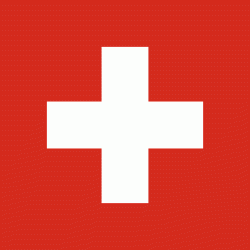Kandersteg
Kandersteg is a municipality in the Frutigen-Niedersimmental administrative district in the canton of Bern in Switzerland. It is located along the valley of the River Kander, west of the Jungfrau massif. It is noted for its spectacular mountain scenery and sylvan alpine landscapes. Tourism is a very significant part of its economic life today. It offers outdoor activities year-round, with hiking trails and mountain climbing as well as downhill and cross-country skiing. Kandersteg hosted the ski jumping and Nordic combined parts of the 2018 Nordic Junior World Ski Championships.
Kandersteg is first mentioned, together with Kandergrund, in 1352 as der Kandergrund.
Prehistorically the area was lightly settled. However, several late-neolithic or early Bronze Age bows have been found on the Lötschberg glaciers and a Bronze Age needle was found in the Golitschenalp. From the Roman era a bridge and part of a road were discovered in the village.
Until 1909 Kandersteg was politically and religiously part of Kandergrund. In 1511 the parish built a chapel in Kandersteg, which survived the iconoclasm of the Protestant Reformation in 1530. It became a filial church of the parish in Kandergrund between 1840 and 1860 and in 1910 became the parish church of the Kandersteg parish. A Roman Catholic church was built in 1927.
Traditionally the local economy relied on seasonal alpine herding and farming and supporting trade over the alpine passes. In the 17th and 18th centuries sulfur mining began in the Oeschinenalp. A match factory opened in the village in the 19th century to take advantage of the sulfur. Beginning around 1850, the municipality grew into a tourist destination. Between 1855 and 1890 five hotels opened and by 1913 there were 19 hotels. The population grew dramatically during construction of the Lötschberg Tunnel and the Lötschberg railway line between 1906 and 1913. The new railroad line and tunnel allowed ever increasing numbers of tourists to visit Kandersteg. A chair lift to Oeschinen Lake opened in 1948, followed by a cable car to the valley floor in 1951. A ski jump was built in 1979. The Kandersteg International Scout Centre opened in 1923.
Kandersteg is first mentioned, together with Kandergrund, in 1352 as der Kandergrund.
Prehistorically the area was lightly settled. However, several late-neolithic or early Bronze Age bows have been found on the Lötschberg glaciers and a Bronze Age needle was found in the Golitschenalp. From the Roman era a bridge and part of a road were discovered in the village.
Until 1909 Kandersteg was politically and religiously part of Kandergrund. In 1511 the parish built a chapel in Kandersteg, which survived the iconoclasm of the Protestant Reformation in 1530. It became a filial church of the parish in Kandergrund between 1840 and 1860 and in 1910 became the parish church of the Kandersteg parish. A Roman Catholic church was built in 1927.
Traditionally the local economy relied on seasonal alpine herding and farming and supporting trade over the alpine passes. In the 17th and 18th centuries sulfur mining began in the Oeschinenalp. A match factory opened in the village in the 19th century to take advantage of the sulfur. Beginning around 1850, the municipality grew into a tourist destination. Between 1855 and 1890 five hotels opened and by 1913 there were 19 hotels. The population grew dramatically during construction of the Lötschberg Tunnel and the Lötschberg railway line between 1906 and 1913. The new railroad line and tunnel allowed ever increasing numbers of tourists to visit Kandersteg. A chair lift to Oeschinen Lake opened in 1948, followed by a cable car to the valley floor in 1951. A ski jump was built in 1979. The Kandersteg International Scout Centre opened in 1923.
Map - Kandersteg
Map
Country - Switzerland
 |
 |
| Flag of Switzerland | |
Switzerland is geographically divided among the Swiss Plateau, the Alps and the Jura; the Alps occupy the greater part of the territory, whereas the Swiss population of approximately 8.7 million is concentrated mostly on the plateau, where the largest cities and economic centres are located, including Zürich, Geneva and Basel.
Currency / Language
| ISO | Currency | Symbol | Significant figures |
|---|---|---|---|
| CHF | Swiss franc | Fr | 2 |
| CHE | WIR Bank | 2 | |
| CHW | WIR Bank | 2 |
| ISO | Language |
|---|---|
| FR | French language |
| DE | German language |
| IT | Italian language |
| RM | Romansh language |















